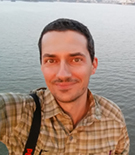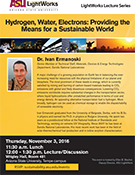Hydrogen, Water, Electrons: Providing the Means for a Sustainable World
Dr. Ivan Ermanoski
- Senior Member of the Technical Staff, Materials, Devices & Energy Technologies Department, Sandia National Laboratories
One of the main challenges of a growing human civilization on Earth lies in balancing the ever-increasing need for resources, with the physical limitations of our planet and biosphere. The most prominent of these needs is energy. Energy is currently satisfied by the mining and burning of carbon-based materials leading to CO2 emissions with global and likely disastrous consequences.
Lowering CO2 emissions worldwide requires substantial changes in the transportation sector, where liquid hydrocarbons offer unmatched performance in terms of cost and energy density on a mass and volumetric basis. An appealing alternative transportation option is hydrogen, intended to initially be used in fuel cell vehicles. More broadly, hydrogen can be used as chemical storage to enable the dispatchability of renewable electricity.
Solar-thermochemical hydrogen (STCH) production is motivated by the understanding that thermochemical cycles can also be used to produce CO from CO2, enabling the synthesis of hydrocarbons, and a smoother transition option toward renewable fuels. Two-step solar thermochemical fuel (STF) production is deceptively simple: it consists of a reduction step, in which oxygen is removed from a reactive oxide, and a step in which feedstock such as H2O is used to reoxidize the oxide and yield fuel.
Ivan Ermanoski is a Senior Member of the Technical Staff at the Materials, Devices & Energy Technologies Department at Sandia National Laboratories, Albuquerque, NM. He graduated from the University of Belgrade, Serbia, with his B.Sc. in physics thesis work “Nanoscale Studies of a Thin Layer of Silver on HOPG”. He earned his Ph.D. in physics at Rutgers, “Nanoscale Properties of Planar and Faceted Ir (210).” Before spending two years as a postdoctoral fellow at the National Institute of Standards and Technology (NIST), working on extreme UV lithography (EUVL). Since 2007 he has been a postdoctoral associate and then a staff member at Sandia National Laboratories. His most recent work has been in the field of solar-thermochemical fuel production, and in iodine sorption characterization.
Host: Ellen B. Stechel, Deputy Director, ASU LightWorks
11:30 a.m. Lunch
12:00 - 1:30 p.m. Seminar/Discussion



